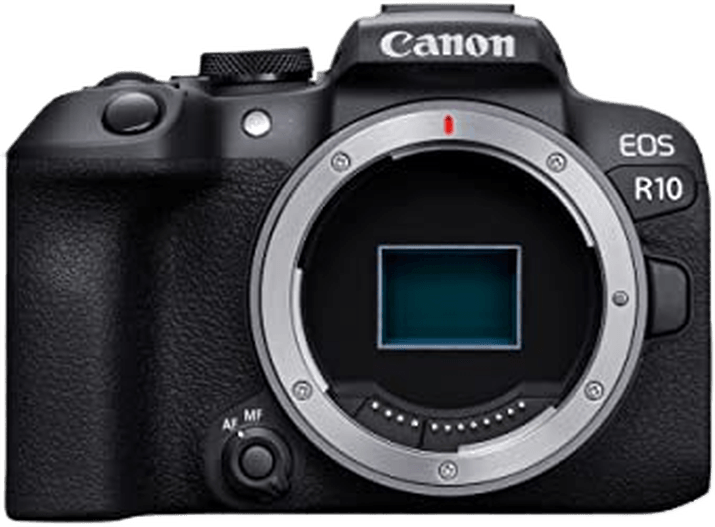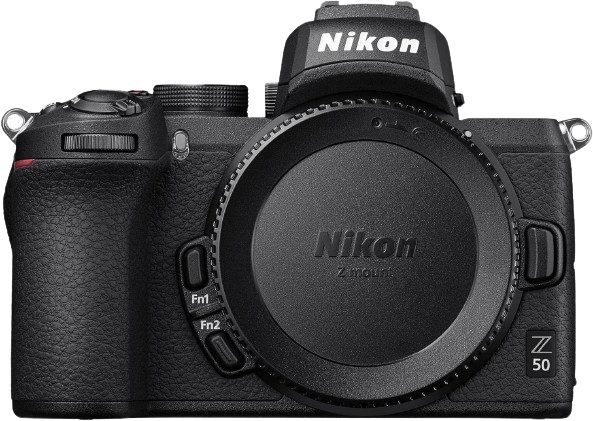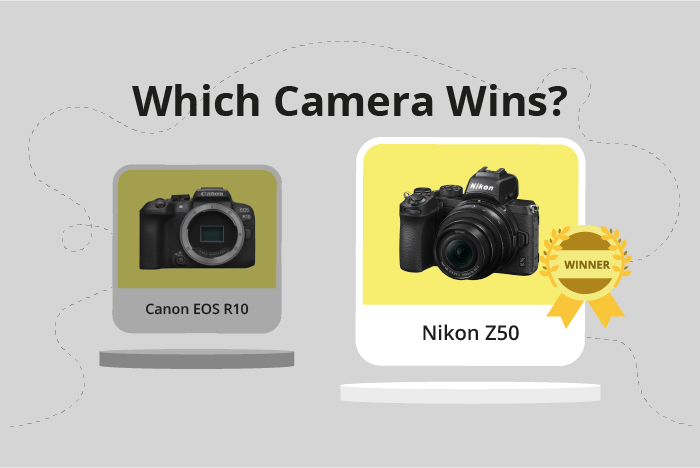Canon EOS R10 vs Nikon Z50 Comparison
Canon EOS R10

Nikon Z50

The Nikon Z50 outperforms the Canon EOS R10 with a score of 73/100 compared to 69/100. Both cameras are mirrorless, released in 2019 and 2022 respectively, and have similar dimensions. The Nikon Z50 is slightly larger at 127 x 94 x 60mm, but also heavier at 450g, while the Canon EOS R10 measures 123 x 88 x 83mm and weighs 426g.
The Canon EOS R10 has a lower launch price of $980, making it more affordable than the Nikon Z50 at $859. The Nikon Z50, however, offers better performance, justifying its higher score. The Canon EOS R10’s lighter weight and smaller size make it more portable and easier to carry around.
Considering these factors, the Nikon Z50 is the superior camera due to its higher performance, despite being slightly larger and heavier. The Canon EOS R10, on the other hand, offers a more budget-friendly option with decent performance and greater portability.
Canon EOS R10 vs Nikon Z50 Overview and Optics
The Nikon Z50 outperforms the Canon EOS R10 in optics, scoring 72/100 compared to the R10’s 71/100. Both cameras share several specifications, including a CMOS sensor, APS-C sensor size, and a lack of image stabilization. They also have the same DXOMARK score for their sensors at 97.
The Canon EOS R10 has a slight advantage in megapixels, boasting 24 compared to the Nikon Z50’s 21. This means the R10 can capture higher-resolution images, which is beneficial for cropping and printing large photos. Additionally, the R10 has a faster shooting speed of 15 frames per second (fps), as opposed to the Z50’s 11 fps. This makes the R10 more suitable for capturing fast-moving subjects, such as sports or wildlife photography.
On the other hand, the Nikon Z50 has its own strengths. While it has fewer megapixels and a slower shooting speed, it still manages to achieve a higher overall score in optics. This could be due to factors such as better low-light performance, color accuracy, or dynamic range, which are not explicitly mentioned in the provided specifications.
Both cameras have their respective lens mounts, with the Canon EOS R10 utilizing the Canon RF mount and the Nikon Z50 using the Nikon Z mount. This factor may influence a photographer’s decision based on their existing lens collection or preference for a specific brand’s lenses.
In comparing the optics of these two cameras, the Nikon Z50 has a slight edge over the Canon EOS R10, despite the R10’s higher megapixels and faster shooting speed. The Z50’s higher overall score signifies that it may perform better in certain aspects not covered by the provided specifications. Ultimately, the choice between these two cameras will depend on the photographer’s specific needs and preferences.
Canon EOS R10 vs Nikon Z50 Video Performance
The Canon EOS R10 and Nikon Z50 both have impressive video capabilities, with each camera earning a video score of 91 out of 100. This tie indicates that both cameras are strong competitors when it comes to recording high-quality videos.
Both cameras have several video specifications in common, which contribute to their high scores. They each boast a maximum video resolution of 4K and maximum video dimensions of 3840 x 2160. Additionally, both cameras have a maximum video frame rate of 120fps, allowing for smooth slow-motion footage. Furthermore, the Canon EOS R10 and Nikon Z50 are equipped with built-in time-lapse functionality, making it easy to create stunning time-lapse videos without the need for additional equipment or software.
Despite the tied scores, there are aspects in which each camera excels. The Canon EOS R10 is known for its exceptional autofocus system, which provides fast and accurate focusing during video recording. This feature ensures that your subjects remain sharp and in focus, even when moving quickly or erratically.
On the other hand, the Nikon Z50 has a reputation for producing rich and vibrant colors in its video footage. This is particularly useful for capturing scenes with a wide range of colors, such as landscapes or events with colorful lighting. The Z50’s color reproduction capabilities make it a top choice for videographers who prioritize aesthetics and color accuracy.
Taking all of these factors into account, it is evident that both the Canon EOS R10 and Nikon Z50 are excellent choices for video recording. Each camera has its own strengths, with the EOS R10 excelling in autofocus performance and the Z50 producing outstanding color reproduction. Ultimately, the choice between these two cameras will depend on the individual preferences and priorities of the videographer.
Canon EOS R10 vs Nikon Z50 Features and Benefits
The Nikon Z50 emerges as the winner in this comparison with a feature score of 86/100, while the Canon EOS R10 trails behind with a score of 70/100. Both cameras share some common specifications, including a touchscreen, flip screen, WiFi, and Bluetooth connectivity. Neither of them has GPS functionality.
The Nikon Z50 excels with its larger 3.2-inch screen, providing a more comfortable viewing and composing experience compared to the Canon EOS R10’s 3-inch screen. Both cameras have the same screen resolution of 1,040,000 dots, ensuring similar image quality when reviewing photos or navigating menus.
Despite the lower feature score, the Canon EOS R10 has some advantages. Both cameras have touchscreen functionality, allowing users to easily navigate menus and adjust settings. The EOS R10, like the Nikon Z50, also has a flip screen, which is useful for capturing images at different angles and for vlogging purposes. WiFi and Bluetooth capabilities are present in both cameras, enabling convenient image sharing and remote control options.
When considering these points, the Nikon Z50 stands out as the better camera due to its larger screen size and higher feature score. However, the Canon EOS R10 does not fall far behind, offering similar features and functionality. Ultimately, the choice between these two cameras will depend on individual preferences and priorities, such as brand loyalty or specific feature requirements. Both the Nikon Z50 and Canon EOS R10 are capable cameras that will serve photographers well in various shooting situations.
Canon EOS R10 vs Nikon Z50 Storage and Battery
The Canon EOS R10 wins in the storage and battery category with a score of 40/100, while the Nikon Z50 scores 35/100. Both cameras have one memory card slot and accept SD, SDHC, and SDXC cards (UHS-I compatible). They also both offer USB charging.
The Canon EOS R10 outperforms the Nikon Z50 in battery life, providing 450 shots per charge compared to the Z50’s 320 shots. This difference makes the R10 more suitable for extended shooting sessions without needing a battery replacement. The R10 uses the LP-E17 battery type.
The Nikon Z50, despite its lower score, still offers a decent battery life of 320 shots per charge, using the EN-EL25 battery type. This performance may be sufficient for casual photographers who do not require long shooting periods.
In this comparison, the Canon EOS R10 proves to be the better choice for those prioritizing battery life and extended shooting capabilities. On the other hand, the Nikon Z50 remains a viable option for casual users who can manage with a slightly shorter battery life.
Alternatives to the Canon EOS R10 and Nikon Z50
Are you still undecided about which camera is right for you? Have a look at these popular comparisons that feature the Canon EOS R10 or the Nikon Z50:

